
A Complete Guide to Schema Markup for eCommerce Sites
Table of Contents
If you’re running an eCommerce site, you’re probably searching for ways to boost your visibility and drive more traffic to your online store. One powerful yet underrated SEO feature to achieve that is schema markup.
Think of schema markup as a language that helps search engines understand your website’s content, including your product listings, prices, reviews, and more.
It improves the accuracy of information that Google understands about your Business and can significantly improve how your site appears in search results. This in turn will lead to higher click-through rates (CTR) and more sales.
It all may sound fairly technical – I’m here to break it down for you.
In this complete guide to schema markup for ecommerce, learn everything you need to know about adding schema to your online store — from understanding why it matters to how to add product markup schema to your most important transactional pages.
What is Schema Markup?
Schema markup is a vocabulary of tags (or microdata) that you add to your site’s HTML code. These tags provide search engines with explicit information about your content and create an enhanced description (a rich snippet) appearing in search results.
For eCommerce sites, this could mean displaying product prices, stock status, review ratings, and more — directly in the search engine results pages (SERPs).
Schema.org, a collaborative project founded by Google, Microsoft, Yahoo, and Yandex, maintains this shared vocabulary. It’s designed to be universal, making it easier for search engines to understand your content.
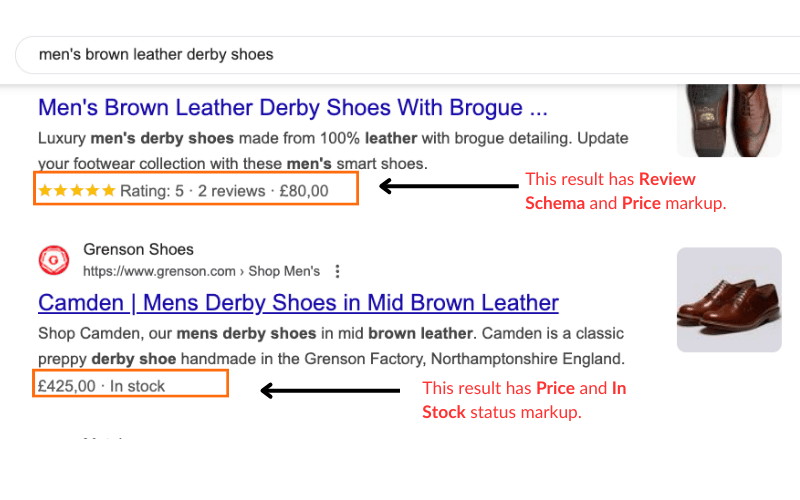
The Purpose of Schema Markup
The primary purpose of schema markup is to provide search engines with additional, explicit information about your website’s content.
When you implement schema markup, you’re essentially telling search engines, “Hey, this isn’t just any text – this is a product name,” or “This number here? That’s the price,” and “These stars represent our customer ratings.”
This clarity helps search engines:
- Interpret your content more accurately, improving your site’s relevance for specific queries
- Create richer, more informative search results for users
- Catalogue your content correctly
While Google has stated that schema markup isn’t a direct ranking factor, the improved clarity and potential for rich snippets can indirectly boost your SEO performance.
According to a study by SearchMetrics, websites using schema markup rank four positions higher on average in search results compared to those without it.
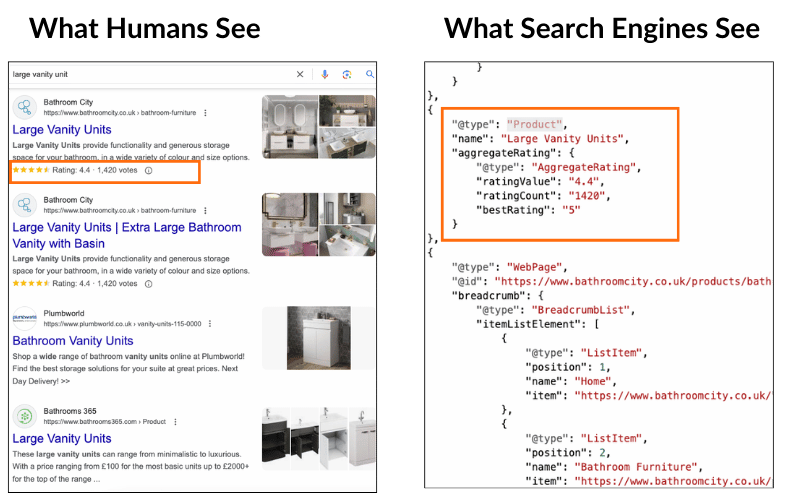
Benefits of Schema Markup for eCommerce
There are many benefits of schema markup for eCommerce sites, from accurate indexing in the SERPs to enhanced engagement that helps beat competition.
1. Help Search Engines Understand Your Pages
Schema markup acts like a translator between your website and search engines. It enables Google (and other search engines) to know exactly what your pages are about.
Instead of guessing, they know this name refers to the SKU, that number is the shipping cost, and those listed items are available colour options.
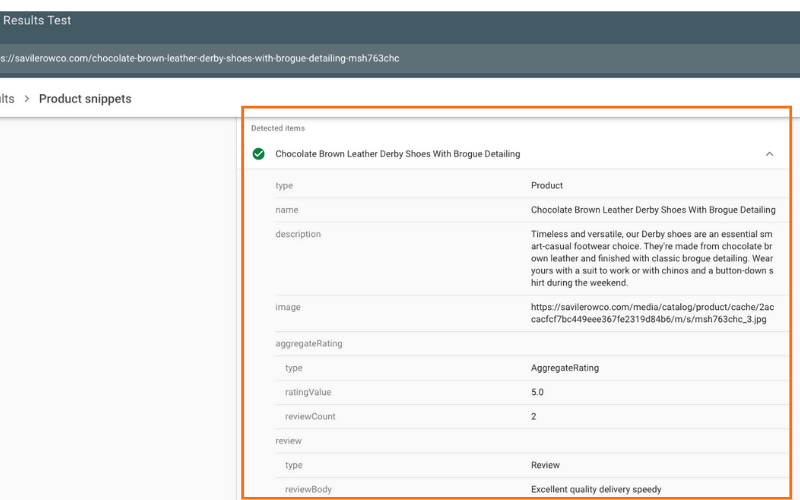
2. Provide Data Sources for the Google Shopping Graph
You may be familiar with Google’s Knowledge Graph, which understands facts about people, places, and things and how these entities are connected.
But Google also has a Shopping Graph, an AI-enhanced model that understands a constantly changing set of products, sellers, brands, and reviews. And your schema markup can feed directly into this, giving your products a better chance of showing up in Google Shopping results.

3. Push Your Site for Getting Rich Results in Search
Imagine a prospect searching for a product you sell. Your result pops up with the price, a five-star rating, and “In Stock” status right there in the search results. Compelling, right?
Schema markup for eCommerce can help your site snag those coveted rich results in the Search Engine Result Pages (SERPs).
Rich results highlighting reviews, ratings, and other social proof builds trust and credibility, resulting in higher Click-through-rates (CTR) for eCommerce listings.
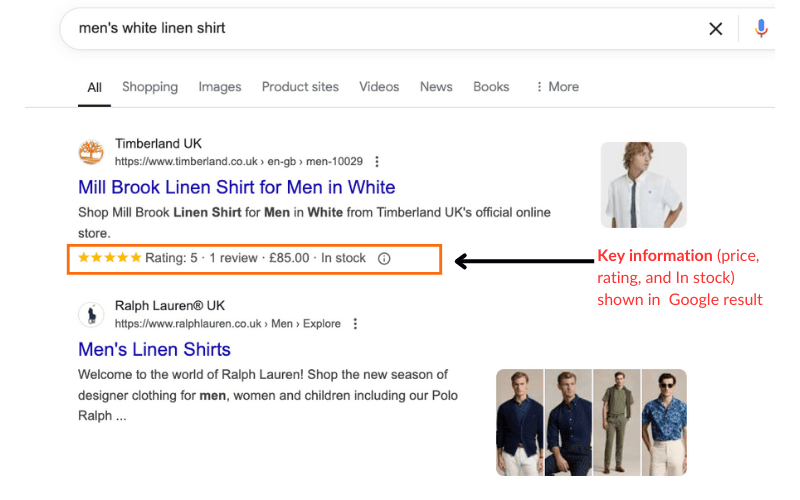
4. Improve Engagement with Searchers
By providing more information upfront in search results, you’re helping potential customers make informed decisions before they even click on your site.
This can lead to higher quality and higher intent traffic, as your potential customers have already seen key information like price and ratings.
A study by Milestone Research shows that rich results have an above-average CTR of 58%, showing increased engagement, while non-rich results fall below average at 41%.
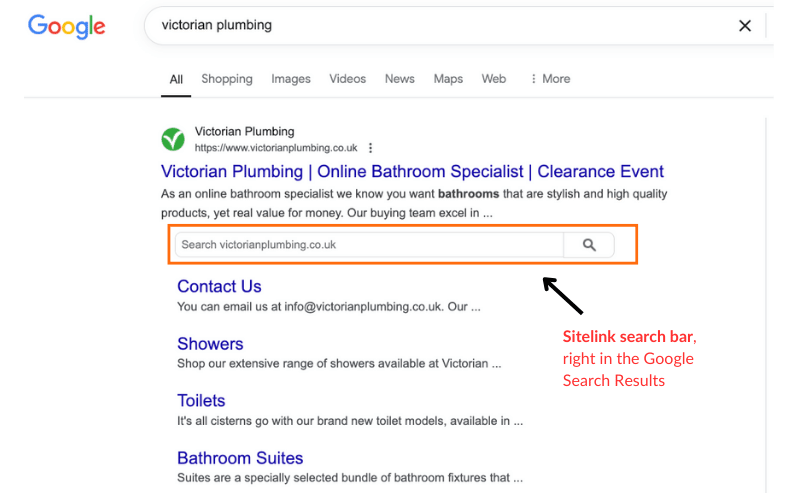
5. Become eligible for a Google Knowledge Panel
Implementing schema markup, especially Organization and Local Business schemas, can make your eCommerce business eligible for a Google Knowledge Panel.
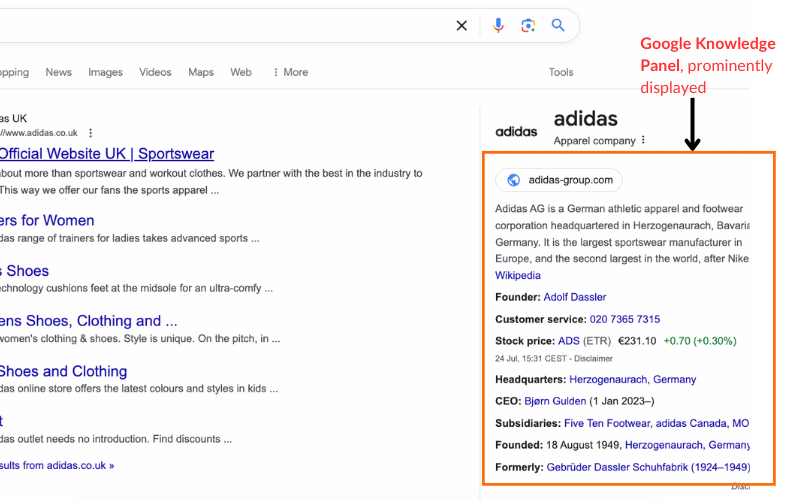
The Knowledge Panel is a prominent information box that appears on the right side of Google search results on desktop (or at the top on mobile) when users search for your business. It displays key details about your business, such as name, description, contact information, and popular products.
Note: Google Knowledge Panel is different from a Google Business Profile. The two may look similar but the Google Business Profile (formerly Google My Business) is specific to local businesses that serve a particular location or a specific geographic radius.
A Knowledge Panel can boost eCommerce SEO by providing users with a quick, comprehensive overview of your business directly in the search results, increasing your brand’s recognition, trust, credibility and conversions.
Note: While schema markup makes you eligible, Google ultimately decides whether to display a Knowledge Panel for your business.
6. Provide Shipping Information within Search Results
Free Shipping is a challenge for ecommerce merchants but can be a critical factor in keeping online shoppers happy.
Based on a Forbes article “In a 2019 survey, 50% of online shoppers said they avoided retailers that did not offer free shipping, and 77% “abandoned a purchase due to unsatisfactory shipping options.”
Despite the survey being dated, the results align with popular consumer psychology. It’s a fact that shipping charges can make or break whether someone buys from you or your competitor.
With the OfferShippingDetails markup, you can provide Product shipping costs to online shoppers, directly in the Google shopping search results. It can work to your advantage, especially if you offer Free shipping to constumers.
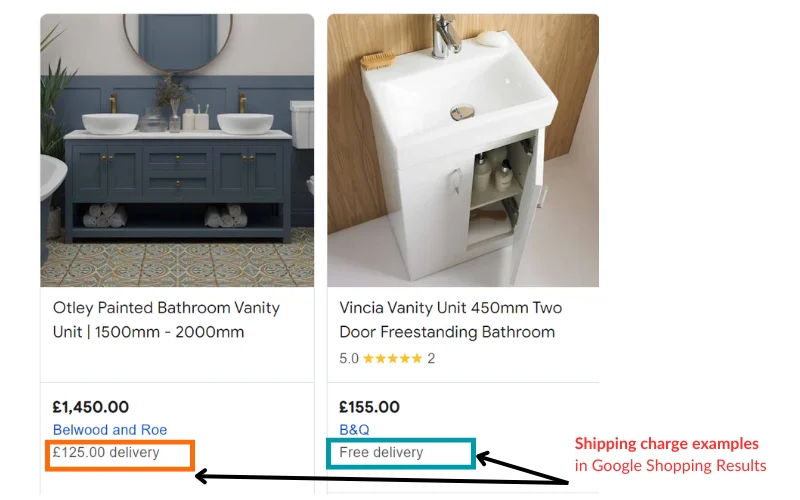
7. Inform Potential Shoppers About Slashed Sale Prices For Products
Who doesn’t love a good bargain! The Offer structured data markup allows ecommerce merchants to show Sale pricing to online searchers.
I have seen it appear prominently in Google Shopping Results. If you’ve wondered how those businesses do it, give the Offer schema property a go

How Schema Markup Works
Structured data markup is machine-readable code that is nested within the existing source code on web pages. This may be HTML tags (Microdata or RDFa) or Javascript notation (JSON-LD).
Search engines and browsers can extract this data, providing a richer browsing experience and more relevant results for users.
You can implement schema markup in three formats:
1. JSON-LD
JSON-LD (JavaScript Object Notation for Linked Data) is currently the most popular and Google-recommended format.
It’s a snippet of JavaScript code that you can add to your web page’s <head> or <body> section within the <script> element.
<script type="application/ld+json">
{
"@context": "https://schema.org/",
"@type": "Product",
"name": "Executive Leather Office Chair",
"image": "https://example.com/chair.jpg",
"description": "Ergonomic office chair with genuine leather upholstery",
"brand": {
"@type": "Brand",
"name": "OfficePro"
},
"offers": {
"@type": "Offer",
"url": "https://example.com/chair",
"priceCurrency": "USD",
"price": "199.99",
"availability": "https://schema.org/InStock"
}
}
</script>
2. Microdata
Microdata is added directly to the HTML code on your page and uses the following specifications:
- Itemscope: Indicates that the HTML contains an item described by schema.org vocabulary
- Itemtype: Specifies the type of item being described, such as Product, Person, or Event
- Itemprop: Defines a property of the item, like name, price, or description
<div itemscope itemtype="https://schema.org/Product">
<h1 itemprop="name">Classic Leather Wallet</h1>
<img decoding="async" itemprop="image" src="data:image/svg+xml,%3Csvg%20xmlns='http://www.w3.org/2000/svg'%20viewBox='0%200%200%200'%3E%3C/svg%3E" alt="Classic Leather Wallet" data-lazy-src="wallet.jpg"/><noscript><img decoding="async" itemprop="image" src="wallet.jpg" alt="Classic Leather Wallet"/></noscript>
<p itemprop="description">Handcrafted genuine leather wallet with RFID blocking.</p>
<div itemprop="offers" itemscope itemtype="https://schema.org/Offer">
Price: $<span itemprop="price">59.99</span>
<meta itemprop="priceCurrency" content="USD" />
<link itemprop="availability" href="https://schema.org/InStock"/>In stock
</div>
</div>
3. RDFa
RDFa (Resource Description Framework in Attributes) is similar to Microdata but can be used in a broader range of document types. RDFa uses a set of attributes to embed RDF statements into HTML, XHTML, and XML documents.
These attributes include:
- vocab: Defines the vocabulary (usually schema.org) being used for the structured data
- typeof: Specifies the type of item being described
- property: Indicates a property of the item
- resource: Points to another web page or item (URL)
- prefix: Declares shortened prefixes for external vocabularies used in the markup (besides schema.org)
<div vocab="https://schema.org/" typeof="Product">
<h1 property="name">Classic Leather Wallet</h1>
<img decoding="async" property="image" src="data:image/svg+xml,%3Csvg%20xmlns='http://www.w3.org/2000/svg'%20viewBox='0%200%200%200'%3E%3C/svg%3E" alt="Classic Leather Wallet" data-lazy-src="wallet.jpg"/><noscript><img decoding="async" property="image" src="wallet.jpg" alt="Classic Leather Wallet"/></noscript>
<p property="description">Handcrafted genuine leather wallet with RFID blocking.</p>
<div property="offers" typeof="Offer">
Price: $<span property="price">59.99</span>
<meta property="priceCurrency" content="USD" />
<link property="availability" href="https://schema.org/InStock"/>In stock
</div>
</div>
Is there a preferred Structured Data Markup format?
Google recommends JSON-LD (JavaScript Object Notation for Linked Data) as the preferred format for implementing structured data markup for a few reasons:
- It’s the simplest solution for website owners to implement and manage across their entire website.
- You can add JSON-LD markup directly in the HTML document’s <head> and <body> elements and it’s kept separate from the “user-visible text” on the page. JSON-LD “markup” works behind the scenes to create the final layout and appearance of the web page, in search results.
- It’s more readable and easily understood by developers and site owners reducing the likelihood of errors.
- Finally, for any modern websites using Javascript, JSON-LD can be dynamically inserted into the page using JavaScript or embedded widgets.
For these reasons, JSON-LD has become the standard for most modern implementations of schema markup, especially for eCommerce sites with complex product information.
How to Implement Schema Markup for eCommerce Product Pages
Implementing schema markup might sound technical, but it’s easily manageable with the right approach.
Let’s break it down into detailed steps:
Step 1: For product pages, you’ll use the ‘Product’ schema type. This can include nested types like ‘Offer’ for pricing and availability and ‘AggregateRating’ for reviews.
Step 2: Gather your product information in a Google sheet or an excel file. Collect all relevant details, including:
- Product name
- Description
- Brand
- SKU or MPN (Manufacturer Part Number)
- Price
- Availability status
- Image URL
- Review ratings (if applicable)
- Anything else that may be relevant to your products
Step 3: Create your schema markup. While you can write JSON-LD code manually, it’s often easier to use tools:
- Google’s Structured Data Markup Helper: This tool allows you to tag elements on your page visually and generates the corresponding JSON-LD code.
- Schema Markup Generators: Tools like Merkle’s Schema Markup Generator can create JSON-LD code based on input fields
- CMS plugins: If you’re not comfortable with direct code manipulation, CMS platforms such as WordPress offer user-friendly plugins like RankMath schema markup and Yoast Schema markup to auto-generate a schema markup for you.
- Schema Modules: CMS platforms such as Drupal have Schema-markup modules to add schema.org structured data to your Drupal site.
Step 4: Add the markup to your page. Once you have your markup code, add it to your product page. It should be placed within a <script> tag in the <head> section of your HTML.
Example of eCommerce schema markup:
<title>Your Product Page</title>
<script type="application/ld+json">
{
"@context": "https://schema.org/",
"@type": "Product",
"name": "Classic Leather Wallet",
"description": "Handcrafted genuine leather wallet with RFID blocking",
"sku": "CLW001",
"brand": {
"@type": "Brand",
"name": "LeatherCraft"
},
"image": "https://example.com/wallet-image.jpg",
"offers": {
"@type": "Offer",
"url": "https://example.com/classic-wallet",
"priceCurrency": "USD",
"price": "59.99",
"availability": "https://schema.org/InStock"
},
"aggregateRating": {
"@type": "AggregateRating",
"ratingValue": "4.5",
"reviewCount": "89"
}
}
</script>
Step 5: Test your markup. Use Google’s Rich Results Test to validate your markup and flag any errors.
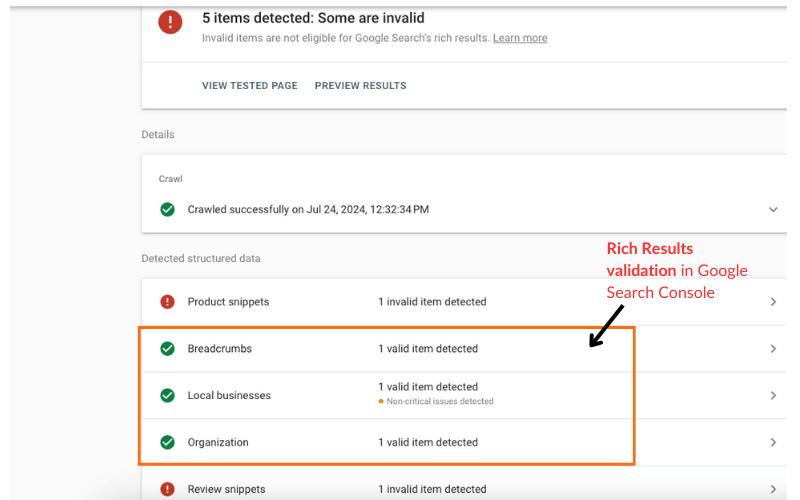
Step 6: Implement across all product pages. After successfully implementing schema markup on one product page, roll it out across all your product pages. Many eCommerce platforms allow you to do this automatically through templates.
Step 7: Track performance. You can use Google Search Console to monitor how pages with schema markup perform in search results. Look for increases in impressions, CTR, and the appearance of rich results.
You can directly check individual product URLs in Google Search Results for updated schema snippet result updates.
Other Important Schema Markups for eCommerce Sites
Schema Markup for Home Page
1. Organization: This schema type provides crucial information about your business:
- Your company name
- Company Logo
- Contact information
- Social media profiles
- Founding date
2. Local Businesses: This schema is essential if your eCommerce business has physical locations. It includes store addresses, opening hours, and contact details that boost your local SEO, helping your stores appear in local search results and Google Maps.
{
"@context": "https://schema.org",
"@type": "LocalBusiness",
"name": "Your Store Name",
"image": "https://www.yourstore.com/store-image.jpg",
"address": {
"@type": "PostalAddress",
"streetAddress": "123 Main St",
"addressLocality": "Anytown",
"addressRegion": "ST",
"postalCode": "12345",
"addressCountry": "US"
},
"telephone": "+1-555-555-5555",
"openingHoursSpecification": [
{
"@type": "OpeningHoursSpecification",
"dayOfWeek": ["Monday", "Tuesday", "Wednesday", "Thursday", "Friday"],
"opens": "09:00",
"closes": "17:00"
}
]
}
3. Sitelinks Searchbox: This schema enables a search box to appear directly in your Google search result. It allows users to search your site without visiting it, potentially increasing engagement. If you want to optimise your homepage for sitelinks schema, go check our guide on How to Get Sitelinks in Google Search Results
4. Breadcrumb: While often associated with internal pages, the home page’s breadcrumb schema can help users and search engines understand your site structure.
Schema Markup for Category Page
1. Breadcrumb: Breadcrumb schema is particularly important on category pages. It shows the path from the home page to the current category, helping users navigate your site, and search engines understand its structure.
2. Review Snippet: Use review snippet schema to display star ratings for your products in search results, potentially increasing Click Through Rate (CTR).
{
"@type": "Product",
"name": "Leather Sofa",
"aggregateRating": {
"@type": "AggregateRating",
"ratingValue": "4.4",
"ratingCount": "1420",
"bestRating": "5"
}
Schema Markup for Product Page
1. Breadcrumb: Similar to category pages, breadcrumb schema on product pages helps understand navigation and site structure.
2. Product Snippet: Details like product name, review information, price, availability, and images can appear in rich snippets, making your listings more attractive and informative.
3. Merchant Listing: This schema provides information about you as a seller, including details about your return policy, shipping options, and any special offers. It can help differentiate your listing in search results.
4. Video Object: If you have product videos, this schema type can help them appear in video-rich results. It includes details like the video’s name, description, thumbnail URL, and upload date.
<script type="application/ld+json">
{
"@context": "https://schema.org",
"@type": "VideoObject",
"name": "Classic Leather Wallet Product Demo",
"description": "Watch our detailed product demo of the Classic Leather Wallet.",
"thumbnailUrl": "https://example.com/thumbnail.jpg",
"uploadDate": "2023-07-17T08:00:00+08:00",
"duration": "PT2M30S",
"contentUrl": "https://example.com/classic-leather-wallet-demo.mp4",
"embedUrl": "https://example.com/embed/classic-leather-wallet-demo",
"publisher": {
"@type": "Organization",
"name": "Your eCommerce Store",
"logo": {
"@type": "ImageObject",
"url": "https://example.com/logo.png",
"width": "600",
"height": "60"
}
}
}
</script>
Schema Markup for Blog Articles
There are two main schema properties that may be used across blogs and informational articles: Blogposting schema and Article schema.
BlogPosting schema is meant for individual posts in a Blog.
Article schema covers a wider set of use cases and may be used for blog posts, news articles or investigative reports.
<script type="application/ld+json">
{
"@context": "https://schema.org",
"@type": "BlogPosting",
"@id": "https://example.com/blog/posts/space-saving-office-furniture",
"headline": "Introducing our new, stylish, space-saving home office furniture",
"description": "Helping you save space, discover our new home office furniture range."
}
</script>
Implementing these various types of schema markup creates a comprehensive structured data strategy for your eCommerce site, improving your visibility across different types of search queries and rich results.
Final Thoughts
In the competitive world of online retail, every advantage counts, and schema markup can give you that edge.
While implementing schema markup does require some technical know-how, the potential benefits far outweigh the initial investment of time and resources.
By implementing schema markup now, you’re not just optimising for today’s search landscape – you’re future-proofing your eCommerce SEO strategy.
If you need more support in implementing schema markup for your online store, our eCommerce SEO specialists can guide you through the process – audit, implementation and performance tracking.
Do you want your Brand to benefit in Google Search from Schema-markup enhancements?
Set up a discovery meet with Medha Dixit, our SEO Director, to discuss your Schema implementation strategy.

